Shooting action sports can be overwhelming and strenuous if you lack the proper knowledge before going out to shoot. Whether you want to shoot motocross, mountain biking, snowboarding, ect.... for the most part all of the same rules apply. Once you start to master these rules your portfolio will benefit from it. Since I get a lot of questions about my action shots I though I would break it down for you guys.
The best way to get better shots is to shoot professional athletes. I'm not saying you need a red bull athlete, local pro or intermediate athletes will get you the shots you want. Just approach them, most of the time they are very friendly towards photographers since you can help get them get exposure, and in turn your building a better portfolio. Worst case is they say no and you look for a different athlete. I think it is vital to shoot the best possible athletes that you have access to. It's like shooting celebrities, even if you don't have the most dynamic shot people will still recognize them and want to know who took that photograph. Just start going to the local ride spot, track, ect... start shooting and make friends. Then they will start inviting you when they go out.
When you are out shooting communicate with the athletes, see what lines they are hitting, what berms they want to blow up, and what jumps they feel good on. If you just show up and start shooting without any clue to how the athletes are feeling about certain areas you're basically running around like a chicken with it's head cut off. It can be a compromise, sometimes what the athlete is feeling won't make for the best composition, or the light might not be what you want. But I have usually found that when you shoot what the athlete is comfortable on they give you the show you came for. Don't be afraid to ask the athlete to try something tho. They are usually down to do whatever it takes to get a good shot.
I have found that when composing your shot that you can go about it two ways. Shoot close with a wide angle, or tight with a telephoto. If I was shooting somewhere with a epic backdrop then I would shoot with a wide angle to include the landscape. When I am shooting at the track I usually shoot with a telephoto. I see a lot of beginner photogs shooting wide at f8 or higher, so the subect is far in the frame, everything is super sharp, the background is boring, so in turn the image lacks interest. Try to keep in mind that you want the viewer to see what the athlete is doing. Try to include the take off and/or landing. Try to be very conscientious of your composition. Try not to have distractions in the background and not to cut off the subject in the horizon line . Make sure the the photographs flows.
With wide angle lenses don't be afraid to get as close as you can to your subject, it can make for a really killer shot. If the subject is going to be closer than 4 feet and moving faster than 15mph i recommend pre-fousing instead of tracking, unless you have a 1dx.
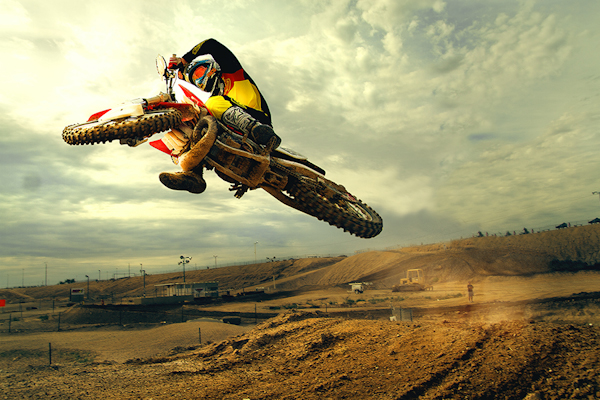

Keep in mind that color can play a huge role in making your athlete pop from the background. I like to keep my color pallets pretty simple and try to keep the number of different colors to a minimum.
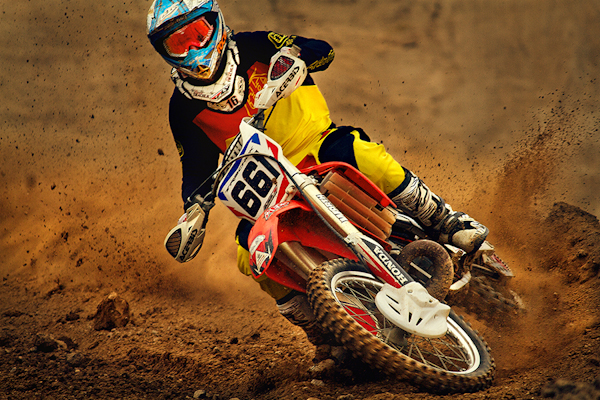
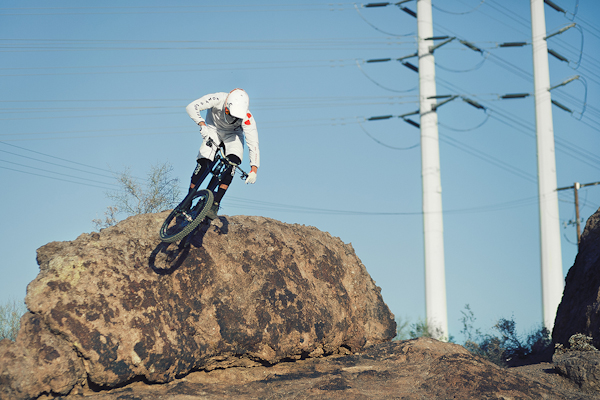
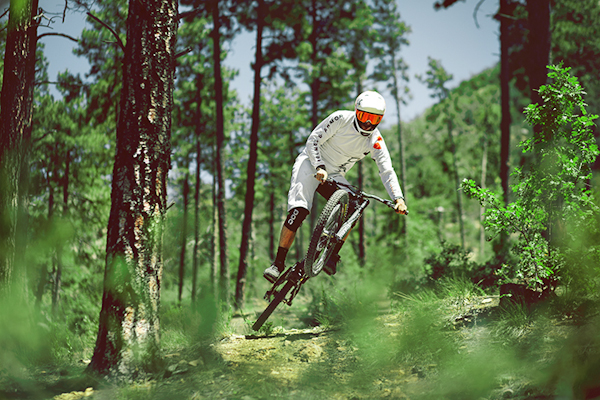
When I use stobes I am very particular on how they fill the scene and light the subject. It can be very easy to not have enough ambient light or poorly places strobes. I usually back light the subject with one strobe and for the front strobe I will have it about 45 degrees from the camera. Remember when back lighting the power does not need to be as powerful as your key light,you want detail in your highlights. I use two 5080ex's on tt5's when I do strobe, thanks to Lear Miller. If you can find someone that is willing to hold a couple reflectors I recommend doing so. You would be surprised how much light you can bounce off a couple 4x6 reflectors, plus its a lot cheaper than strobes and in mid day more effective.
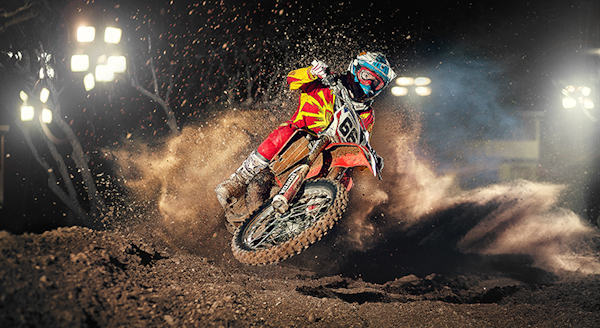


Get creative. Photography is a relentless industry with every photographer trying to be the next big thing. Try new angles, light set ups, ect... The more you try new thing the more likely you will develop your own style. Ask the athletes what they think would be a cool shot.

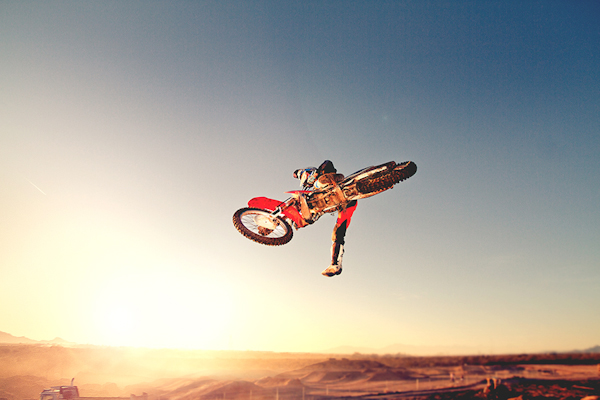
Being that it is such a competitive industry any advantage you have will only put you that much more ahead. Photoshop is such a powerful tool and in my opinion a necessity to get the most out of your image. I usually spend quite a bit of time on an image to make sure it is exactly how I envisioned it. I tend to underexpose my shots by about a half stop. I do this because once in photoshop I will open the image, make my adjustments in raw, open the image, then re-open it in raw add about a full stop on the exposure slider and open it. Then I will take the two images and blend them together using layer masks. For post work I do a lot of dodging and burning and selective color adjustments. I also open a B&W layer and turn it to soft light. Use layers mask to fine tune your layer adjustments and really get the most out of your image.
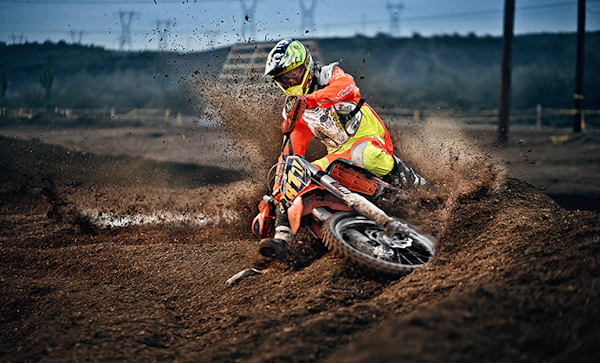

Don't be afraid to shoot at high ISO's. With the noise reduction software available you shouldn't hesitate to crank that camera up to 6,400 iso.
Both the images below were shot at 6,400 iso.

I own both a Canon 7D and 5Dc, and I honestly tend to lean towards the 5Dc. The reason being is that I don't really need the frame rate and focusing on the 7D since I tend to pre-focus and wait till the subject enters the shot and pray. To me full frame just has so mush more to offer. But that doesn't mean I don't need the 7D for some occasions. My only point is don't get hung up on what camera and lens you have. None of my shots have been shot on L glass. I use a tamron 17-50, 85mm f1.8, and a kit telephoto lens that i think is a 70-250mm. Don't let your discouragement jeopardize you from going out and shooting.




Most importantly have fun and make friends. I hope you were able to learn something and if you have any questions on something I didn't cover or a specific set up for a shot feel free to ask.







good article and some strong points made. one point i think should be touched on is understanding the sport you are shooting.
You make a good point, knowing the culture and atmosphere of each sport will benefit you greatly.
Ya this is a great point. It's certainly important to have know the ins and outs. I on the other hand shoot climbing and can imagine adapting some aspects but have often thought about what major shifts i would need to make in lighting etc.
another culture... http://www.facebook.com/media/set/?set=a.343924398957462.100313.34243625...
I think you should not attempt action sports photography if you are not accociated with the particular sport or do it on your own as well.
and why is that
Ya this seems super ignorant. You shouldn't eat pizza unless you make pizzas or are associated with pizza...
wow...are you serious?
Nice post!
Thank you very much!
Thanks! Do you have any tips on how to get into events? I've been shooting local amateur sporting events and I feel that I am ready to give a pro game a go. How would you go about getting in? Who would you contact and how? Thanks!
The key to getting event credentials is having a media relation; magazine, site or blog.
Start at amateur places, and go pro with the athletes. Thats how I made the jump. See my comment above. I think action sports photography is the type of photography where you really have to grow in, there is no receipe as for wedding or headshot photography. Its about understanding how the athlete wants to look and combining that with you base knowledge of photography. (haters of grammar and spelling: I dont care, you get the point of what I am talking about).
What is it that you want to shoot? Like Jason said tho, most of the time you need credentials to get access to shoot big events.
Nice article Thomas! I am with you in all your points. Screw pro gear, shoot with good and motivated athetes and use post production to take everything out of your images.
And shoot, shoot, shoot,....
I agree that gear doesn't count for everything. Hell, I shoot with a $50 19-35mm lens sometimes...I did yesterday in fact. But as far as relying on post, thats not exactly a good idea. If you ever want to submit to magazines or even for web content, 99% of the respectable companies out there want an untouched RAW file. Every magazine I submit to, I have a multi-page PDF from them about photo submissions and that is the #1 point in all of them.
That's also true Zach. I have some experience with magazines, too. However If you take a nice photo and say like "that's the shot of the day" and you come home go into lightroom/aperture/etc. and only tweek 3-4 sliders you are giving away a lot of potential, that is still in the image. That's what I meant with 'and use post production'.
I agree that you can sometimes get away with a few tweaks and post is not a bad thing at all. I would say, if anyone is just getting started and they think they might want to submit to magazines, contact their photo editor. Get a list of guidelines of what they are looking for, how much you can edit or if you can edit, and how their submission process works. Most of the companies I submit to, I'm not really allowed to do any tweaks other than cropping. But even then, I have to submit the cropped and original of the image and explain why I cropped. Relying on post is just a bad habit if you have to deal with companies that strict.
Although I agree that you should not rely on photoshop to "save" you, For the style of shooting I do spending an hour on an image in ps is worth it
You mentioned not to pop a lot of color in your pallette. But I never used certain 'swatches' in that way. Is there a possiblity you can show some light on the subject or an article?
Are you referring to how I use photoshop and selectively adjust my colors?
Looking for a little clarification here, Max Leitner ... are you saying that if I do not belong to, say, a boxing club and I don't box myself, that I should not attempt to shoot a sanctioned/official boxing match?
See my comment above. I can only speak for cycling. Specific, MTB. I would not attempt to shoot boxing, maybe if I had a friend who does it and who I can spend lots of time with to get my vision dialed on the sport.
I just had to comment because your pictures are mind-blowing. I liked every one you showed here.
Thank you for sharting those tips too, I like sports but now i realize I haven't been really looking for cool shots.
Who is the Photographer?
Great article thanks! Would you use the same lighting setup for shooting snowboarding? What about this article from Dan Carr? http://theskiphotographer.com/dan-carr-gear-list/flash-gear/
This quote has me very confused: "I do this because once in photoshop I will open the image, make my adjustments in raw, open the image, then re-open it in raw add about a full stop on the exposure slider and open it. Then I will take the two images and blend them together using layer masks. For post work I do a lot of dodging and burning and selective color adjustments. I also open a B&W layer and turn it to soft light. Use layers mask to fine tune your layer adjustments and really get the most out of your image."
Can someone explain what is being referred to here ? "Open the image, then re-open it in raw, add about a full stop and open it"
Thanks
J
What he does is to actually open the same RAW-file twice, both in Adobe camera raw and then on to open it in photoshop. The difference between the two versions of the RAW file is 1 stop of exposure done in camera raw. He then puts the images on top of each other as layers in the same document.
This is more or less a way of creating a HDR-looking image from one RAW-file. When you mix the two image together as layers, you can mask in the parts of the dark/light image you want to see in the final result. And the tone will be globally 1 stop lighter in the light image.
Im guessing the reason for doing it this way that he gets better looking tones than if he used a curves adjustment layer or ordinary dodging/burning on just one image opened in RAW->photoshop.
Did that make sense, or is my english as poor as I think it is? :S
Great post Thomas, very impressed by what you're able to do with minimal gear. Well done.
I'm glad that you mentioned not being afraid to using high ISO's at night, but it isn't a bad idea for daytime shots as well. I accidentally found that when shooting in broad daylight, exposure comping up causes the camera to use a higher auto ISO when in AV mode. The accidental part of that is that it exposes detail in the darker areas, especially if I'm shooting on the shadow-side of the players, which in turn makes it very easy to balance the contrast more effectively in post.
Being a Action Sports Photographer as well, I'd love to see your workflow in lightroom/photoshop. Your end resulting images look gorgeous!
.
The comments on this post really ticked me off. This site seems to have
to many people who are negative and critique but yet those who critique
rarely ever produce. I believe those who are truly gifted walk softly
and carry a big stick, not speak about how poorly everyone else is.
Tell me about it. We are revamping the FS website here soon to prevent this....soon everyone who leaves a comment will have to have a portfolio to back up their words!
That is awesome. Brilliant idea.
How do you prefocus?